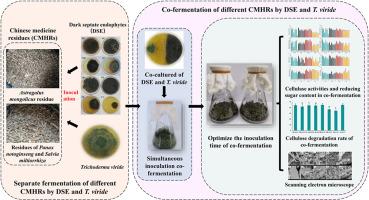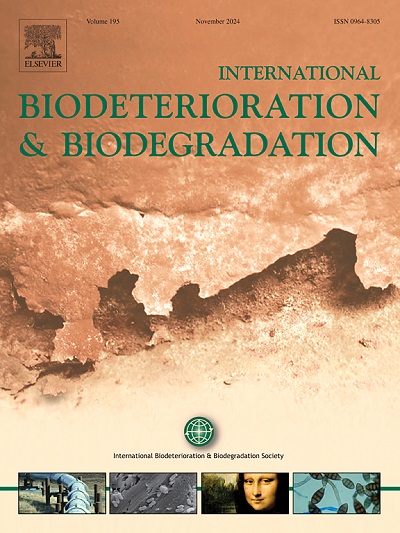暗色隔内生菌和毛霉共同发酵可有效降解不同中药渣中的纤维素
IF 4.1
2区 环境科学与生态学
Q2 BIOTECHNOLOGY & APPLIED MICROBIOLOGY
International Biodeterioration & Biodegradation
Pub Date : 2024-11-05
DOI:10.1016/j.ibiod.2024.105949
引用次数: 0
摘要
中药渣是目前被广泛忽视的可再生生物质资源,开发可控的中药渣微生物发酵技术将有助于实现中药渣的资源化利用。本研究结合各种纤维素酶的活性、还原糖含量和纤维素降解率,评估了暗隔内生菌(DSE)和毛霉菌在不同中草药残体(单一黄芪残体、三七和丹参的复合残体)的单独发酵和联合发酵中的固态发酵(SSF)潜力。结果表明,一些 DSE 菌株的纤维素酶活性高于毒死蜱。单纯的病毒发酵可增加底物还原糖的含量,而 DSE 发酵则可降低底物还原糖的含量。DSE菌株,如假嗜酸性大酵母菌、Paraboeremia selaginellae、Paraphoma chlamydocopiosa和Paraphoma radicina,具有与T. viride共同发酵的潜力。通过在 DSE 3 d 或 6 d 后接种 T. viride 来优化发酵过程,可有效提高共发酵 CMHR 的纤维素酶活性。优化后,不同发酵组合的滤纸纤维素酶、羧甲基纤维素酶和β-葡萄糖苷酶的活性分别达到了2.51-5.61、2.86-4.72和12.85-32.35 U/g 。此外,DSE 和毒死蜱共同发酵可有效降解不同 CMHR 中的纤维素,降解率为 54.43%-67.38%。扫描电子显微镜证实,DSE 和病毒菌共同发酵能增加 CMHR 的外表面积和孔隙率,破坏 CMHR 的结构。该研究结果为微生物降解单一和复合中草药残渣提供了依据,对解决中草药残渣等废弃物的处理和进一步资源化利用具有重要意义。本文章由计算机程序翻译,如有差异,请以英文原文为准。

Co-fermentation of dark septate endophytes and Trichoderma viride can effectively degrade cellulose in different Chinese medicinal herbal residues
Chinese medicinal herbal residues (CMHRs) are currently a widely overlooked renewable biomass resource, and developing controllable microbial fermentation technology for CMHRs will help achieve the resource utilization of CMHRs. In this study, the activity of various cellulases, reducing sugar content and cellulose degradation rate were combined to evaluate the solid state fermentation (SSF) potential of dark septate endophytes (DSE) and Trichoderma viride in separate fermentation and co-fermentation of different CMHRs (single Astragalus mongolicus residue and compound residues of Panax notoginseng and Salvia miltiorrhiza). The results showed that the cellulase activity of some DSE strains was higher than that of T. viride. T. viride fermentation alone could increase the content of substrate reducing sugars, while DSE fermentation could reduce the content of substrate reducing sugars. DSE strains such as Macrophomina pseudophaseoline, Paraboeremia selaginellae, Paraphoma chlamydocopiosa and Paraphoma radicina had the potential to co-ferment with T. viride. Optimization of the fermentation process by inoculation of T. viride after 3 d or 6 d of DSE effectively increased the cellulase activity of co-fermented CMHRs. After optimization, the activities of filter paper cellulase, carboxymethyl cellulase, and β-glucosidase in different fermentation combinations reached 2.51–5.61, 2.86–4.72 and 12.85–32.35 U/g, respectively. Further, the co-fermentation of DSE and T. viride effectively degraded cellulose in different CMHRs with a degradation rate of 54.43%–67.38%. Scanning electron microscope confirmed that the co-fermentation of DSE and T. viride could increase the external surface area and porosity of CMHRs, and destroy the structure of CMHRs. The results of this study both provided a basis for the microbial degradation of single and compound CMHR, which is of great significance for solving the treatment of waste such as Chinese herbal residue and further resource utilization.
求助全文
通过发布文献求助,成功后即可免费获取论文全文。
去求助
来源期刊
CiteScore
9.60
自引率
10.40%
发文量
107
审稿时长
21 days
期刊介绍:
International Biodeterioration and Biodegradation publishes original research papers and reviews on the biological causes of deterioration or degradation.

 求助内容:
求助内容: 应助结果提醒方式:
应助结果提醒方式:


